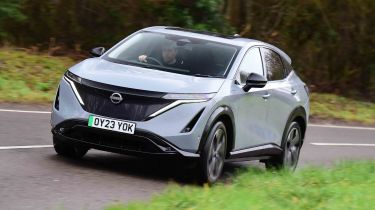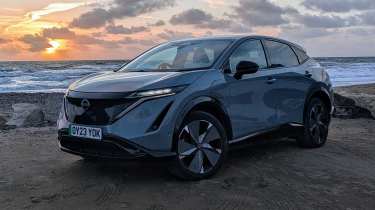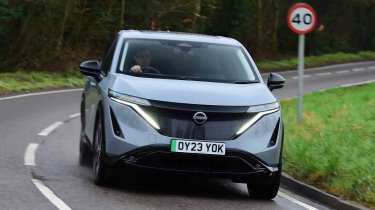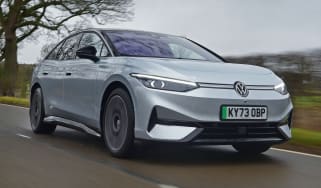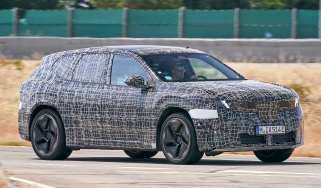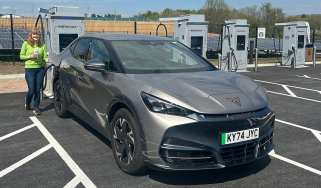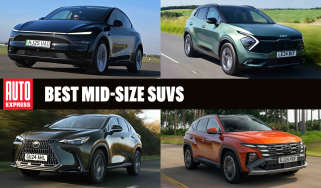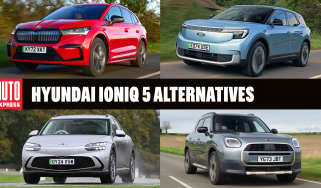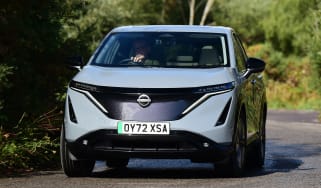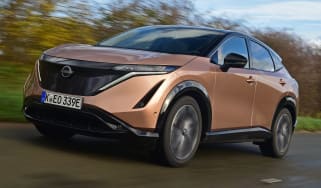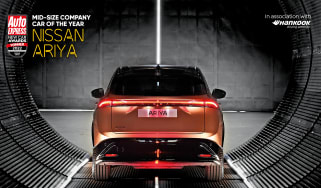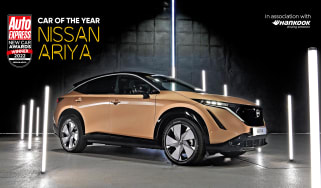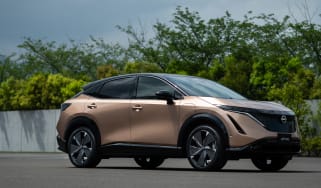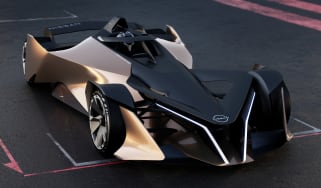Nissan Ariya review
For family buyers contemplating the switch to electric motoring, the Ariya is a capable and upmarket-feeling option

Our opinion on the Nissan Ariya
The Nissan Ariya is a fine effort from the Japanese brand. This all-electric family SUV boasts a breadth of capability that will come as a welcome surprise to buyers, and is up with both the best cars of its type..
The Ariya is great to drive for a mid-size SUV, while decent practicality, refinement and a premium cabin add further appeal.
Pricing is competitive compared to its close EV rivals, although its overall efficiency lags behind the best in class – which is a shame considering the healthy battery capacity the Ariya has. That aside, the Nissan Ariya is a fantastic choice that we can wholeheartedly recommend.
Key specs | |
| Fuel type | Electric |
| Body style | 5-door SUV |
| Powertrain | Single electric motor (FWD) or dual electric motor (AWD) |
| Safety | 5 stars |
| Warranty | 3-year/60,000-mile |
About the Nissan Ariya
Nissan has an established reputation for producing capable family SUVs, while the Nissan Leaf hatchback was a trailblazer in the electric car space. There’s no doubt that Nissan let its position as an EV leader slip a little by taking several years to follow up on the second-generation Leaf, but the Ariya draws upon the brand’s SUV and EV know-how to impressive effect, helping to put Nissan back in the game.
Every model in Nissan’s passenger car range now includes some form of electrification: the smaller Nissan Juke crossover features both mild and full-hybrid set-ups, and Nissan’s innovative e-Power petrol/electric system drives the Nissan Qashqai and Nissan X-Trail.
Used - available now

2024 Nissan
Ariya
8,613 milesAutomaticElectric
Cash £23,995
2024 Nissan
Ariya
10,451 milesAutomaticElectric
Cash £23,845
2024 Nissan
Ariya
2,291 milesAutomaticElectric
Cash £27,996
2024 Nissan
Ariya
6,017 milesAutomaticElectric
Cash £22,849The Ariya is similar in size to the X-Trail, residing at the larger end of the mid-size SUV class, and it combines family car practicality with the zero-tailpipe emissions of all-electric power. It benefits from a significant step up in quality over other recent models in Nissan’s lineup, too, so much so that we awarded the Ariya our Car of the Year title for 2022.
The Ariya is based on the CMF-EV platform, which also underpins the Renault Megane and the Renault Scenic under Nissan’s Alliance partnership with the French brand. Two battery options are available in the Ariya: a 63kWh (usable capacity) model with a range of about 250 miles or a larger 87kWh (also usable capacity) unit with a claimed maximum range of 329 miles.
Front-wheel drive is standard and will cater for most needs, but if you’re after the extra traction reassurance of four-wheel drive in slippery conditions, you’re in luck. The top-of-the-range Ariya e-4ORCE uses a dual-motor set-up to drive all four wheels and deliver 389bhp. This version also features the largest 87kWh battery. However, the extra performance on offer and the weight penalty of the four-wheel drive system mean overall range takes a small hit in these higher spec Ariyas, with Nissan claiming you’ll be able to cover around 310 miles before needing to recharge. There is also a flagship Nissan Ariya Nismo performance model that uses the same dual-motor powertrain but has 429bhp on tap.
When it comes to the mainstream trim levels, things are kept relatively simple, with three core options to choose from: Engage, Advance and Evolve. The standard equipment level is generous, and a small selection of option packs are available. Just below the Nismo sits the Evolve+, but this is also only available with the e-4ORCE powertrain.
Tempted by the Nissan Ariya? If so, we can help you configure your ideal Nissan Ariya and find top offers from over 5,500 UK dealers. You can also take a look the latest Ariya leasing deals or search for used Ariya models with our Find A Car service. You can even sell your existing car for a great price with Auto Express Sell My Car.
Performance & driving experience

Pros |
Cons |
|
|
Despite being a relatively tall and heavy electric SUV, the Nissan Ariya has been engineered to deliver a surprisingly decent drive. It manages to balance offering more accurate handling than many of its close rivals, with the need to provide the comfortable ride expected of an SUV designed for family life. The Ariya’s battery pack is positioned under and towards the middle of the car, helping to create a low centre of gravity and a near-equal front-to-rear weight distribution. This means the Ariya feels more agile than expected, and the precise steering adds to this impression.
You can always feel the hefty kerb weight (around 1,950kg for the 63kWh battery, front-wheel-drive cars and 2,220kg in the 87kWh 4x4 models) when you try to drive quickly, and the Ariya isn’t as fun to drive as the more dynamic Kia EV6. The Nissan has the advantage of being more comfortable and refined, though.
Switch the drive mode to Sport, and the throttle set-up becomes noticeably sharper while the steering gains a lot of weight. You also get a loud simulated powertrain whine like a sci-fi flying saucer, but the whole experience isn’t really in keeping with the Ariya’s strengths. We think it’s best to keep it in the more comfortable settings.
Performance, 0-60mph acceleration and top speed
The entry-level 63kWh model delivers 214bhp and 300Nm of torque from its single electric motor, which drives the front wheels. This allows it to achieve the 0-62mph benchmark in a reasonable 7.5 seconds. Upgrading to the 87kWh battery gets you a stronger 239bhp electric motor, which helps mitigate the negative effects of the extra weight of its larger capacity battery pack. However, acceleration is still slightly impeded, because 0-62mph is dispatched in a marginally slower time of 7.6 seconds.
If you’re prepared to spend over £50,000 on your family wheels, then you might want to consider the 302bhp all-wheel drive Ariya e-4ORCE. These Ariyas generate 600Nm of torque, rocket from 0-62mph in 5.7 seconds, and have a 124mph top speed. If that’s not enough, though, the e-4ORCE Evolve+ ups the power to 389bhp, further reducing the 0-62mph sprint time to 5.1 seconds. Those looking for the ultimate Ariya can go for the Nismo version with 429bhp and a 0-62mph sprint time of 5.0 seconds.
The Nissan Ariya presents buyers with a choice of two battery sizes, 63kWh and 87kWh. That means the official WLTP combined driving range is between 247 and 329 miles, depending on the model chosen. Higher-specification cars, particularly those with e-4ORCE all-wheel drive, are heavier and have a reduced range, while the same is true of the Nismo models with extra power.
As the Ariya is an electric car, both company car tax and VED road tax are very reasonable compared to hybrid and petrol alternatives. Insurance costs are on the high side, but there’s not a huge difference in cost between the entry-level cars and the higher spec ones.
The Ariya Nismo may tempt those who desire high performance, because Nissan’s performance sub-brand has some serious pedigree behind it with the likes of the GT-R and 370Z on its books. Sure, it’d be unfair to compare this family car to a fully-fledged sports car, but we can’t help feeling that the engineers were held back from unleashing this electric SUV’s true potential.
While the 429bhp headline figure is a significant step up from the rest of the Ariya line-up, it’s overshadowed by the Hyundai Ioniq 5 N’s 641bhp. Make no mistake, this Nissan’s five-second 0-62mph isn’t exactly slow, but we felt there was a distinct lack of engagement whenever we tried to chuck it around a bit during testing.
The light steering fails to provide any proper feedback, while the stiffened suspension leaves you at the mercy of the Ariya’s hefty kerb weight and doesn’t do much to make things more fun when the car is aimed towards a corner. The Nismo is likable enough but we struggle to see the point of forking out the extra cash over a regular model.
Town driving, visibility and parking
Driving in and around town is pretty effortless, thanks mainly to the accelerator that responds smoothly to inputs, plus the Ariya can move seamlessly between its regenerative braking system and mechanical braking. There’s no jerkiness or uncomfortable jolts as you slow to a stop, which is a real plus point when driving in heavy traffic.
B-road driving and handling
The Ariya’s suspension is more than accomplished at dealing with the typical imperfections of UK roads. Bigger bumps can send shudders through the car, but on half-decent surfaces, it’s good at cosseting its occupants - even on the larger 20” wheels - compared to the average electric SUV. The firm set-up helps keep body roll in check unless you up the cornering speeds, plus there’s plenty of grip to allow you to tackle B-roads confidently.
Motorway driving and long-distance comfort
Long motorway journeys are a breeze in the Nissan Ariya. It’s a very composed and refined cruiser with little wind noise and not too much roar from the tyres. The steering is well-judged to make it effortless to track straight at speed and stay in your lane without frequent adjustment.
| Model | Power | 0-62mph | Top speed |
| Nissan Ariya 63kWh FWD | 214bhp | 7.5sec | 100mph |
| Nissan Ariya 87kWh FWD | 239bhp | 7.6sec | 100mph |
| Nissan Ariya 87kWh AWD | 302bhp | 5.7sec | 124mph |
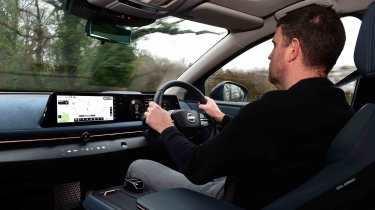
“This car doesn’t feel anything like as enjoyable to drive as the feisty acceleration figures suggest. Although grip is plentiful and deploying the power is never an issue with the 4x4 system standing by, the Ariya’s weight is felt through the corners.” - Steve Walker, head of digital content, who lived with an Ariya e-4orce for six months on a long-term test.
Range, charging & running costs
Pros |
Cons |
|
|
While its near-£40,000 starting price isn’t exactly small change, the Nissan Ariya should prove pretty easy on the wallet in terms of everyday running costs — provided you charge it at home.
As with all EVs, company car drivers can enjoy a very low Benefit-in-Kind tax rate. However, unless you opt for a completely bog-standard, entry-level model, virtually all Ariyas fall foul of the luxury car tax.
Electric range, battery life and charge time
Opting for the entry-level Nissan Ariya 63kWh Engage model means the overall range is a claimed 250 miles. Moving up to the 87kWh version with the Advance trim level sees an increase in range to 329 miles, while Nissan states that the 302bhp dual-motor e-4ORCE variant can cover up to 319 miles. All of these range figures are slightly reduced if you upgrade to the Evolve specification, which brings additional equipment and extra weight to the car. The even hotter Nismo variant, meanwhile, drops the range further to 261 miles.
An energy-efficient heat pump is provided as standard. This helps preserve the vehicle's range by more efficiently heating the interior in cold weather. It’s useful for longer trips during winter months and something reserved for the options list of rivals like the Skoda Enyaq and Volkswagen ID.4.
The additional power of the Ariya Nismo inevitably comes at the cost of some battery range. If you don’t mind making this sacrifice, the result is a WLTP combined range of 261 miles, but this does seem rather puny considering the sheer bulk of the 87kWh battery pack.
With the Ariya capable of charging at up to 130kW, it should take around half an hour or so to complete an 80 per cent top-up of either battery size. We’d like overall efficiency to be a little better, however: the Ariya 63kWh Advance managed 3.7 miles per kW/h during our test, but other EVs, such as the Genesis GV60 and Skoda Enyaq can record in excess of four miles per kWh. Our test of the 87kWh e-4ORCE model saw returns in the region of 3.0m/KWh, getting up to 3.2m/kWh on longer runs.
If you decide the all-electric Ariya is the right family car for you, you’ll want to organise a good home charging set-up. Fully replenishing the 63kWh battery in base model Ariyas will take 10 hours from a 7.4kW home wallbox, while those with the larger 87kWh battery will need to be plugged in for roughly 14 hours.
Model |
Battery size |
Range |
Insurance group |
| Nissan Ariya Engage FWD | 63kWh | 250 | 31A |
| Nissan Ariya Engage FWD | 87kWh | 329 | 33A |
Insurance groups
Getting insurance for the Ariya won’t be cheap compared with a regular petrol or diesel family SUV, because even the entry-level 63kWh Engage model sits in group 31 (out of 50). Go for the larger 87kWh battery and it’s in group 33, while choosing an e-4orce 4x4 variant will see the insurance group jump to 41. The high-performance Nismo variant also sits in group 41.
The Ariya’s insurance groups are also on the high side compared to EV rivals with the entry-level Hyundai Ioniq 5 Premium in group 36, while the Skoda Enyaq starts as low as group 24.
Tax
Electric cars no longer qualify for free road tax (VED) in the UK, so Ariya drivers will now find themselves forking out £195 per year. You’ll also have to pay to drive into the London Congestion Charge zone.
There’s still some good news for company car drivers at least, as they can still make the most of the Benefit-in-Kind (BiK) savings that the full-electric Ariya attracts. This is still a big saving compared to an equivalent petrol, diesel or hybrid family SUV.
Depreciation
The Ariya is predicted to retain between 40 and 46 per cent of its original value after a typical three-year/36,000-mile ownership period. The entry-level Engage models hold their value best, with the e-4orce 4x4 cars losing most.
That’s a similar retained value performance to the Hyundai Ioniq 5, which retains around 43 to 47 per cent, although not quite as good as the Skoda Enyaq, which should retain between 50 and 57 per cent over the same period.
To get an accurate valuation for a specific model, check out our free car valuation tool...
Interior, design & technology

Pros |
Cons |
|
|
At first glance, the all-electric Nissan Ariya offers plenty of kerb side appeal. Buyers will need to recalibrate their expectations about a Nissan family SUV because we think it outclasses anything else the Japanese manufacturer currently has in its line-up.
The Ariya has a distinctive exterior design (shown to great effect in Akatsuki Copper paint), but it's inside the cabin where buyers will be seriously impressed. The level of perceived quality is excellent, and better than you’ll find in most Volkswagen ID-badged rivals.
It’s a straightforward choice in terms of equipment levels; the entry-level Engage model is flush with useful kit and technology, but the mid-range Advance adds luxuries like wireless phone charging, a 360-degree camera system, an electric tailgate, plus heated front seats and steering wheel, along with a heated windscreen.
If you step up to Evolve trim, you get all these features, along with adaptive high beam headlights, ventilated front and heated rear seats, Nissan's ProPilot Park system, and the electric sliding centre console, among other luxuries. Upgrading to Evolve spec over Advance costs around £4,000, though, so we’d save some money and stick with the regular Advance trim.
There are also a few option packs you can add, such as an openable panoramic sunroof as part of the ‘Sky Pack’, as well as the ‘Tech Pack’, which includes a 10-speaker Bose sound system, head-up display, and digital rear-view mirror. The Sport Pack gives you 20-inch wheels and the very fetching Blue Nappa leather seats for just under £2,000.
Nismo buyers largely get the same cabin as the standard car, but a few unique and sporty touches are included such as a 12 o’clock mark on the steering wheel, blacked-out wood trim and a red starter button.

Interior and dashboard design
The Nissan Ariya’s cabin is probably its biggest strength. The wood-effect trim combines well with the premium-feeling upholstery, while the ambient lighting — inspired by traditional Japanese lanterns — is a smart touch.
Instead of traditional dials to operate the heating and ventilation functions, Nissan has used a series of haptic controls set into the dash below the 12.3-inch infotainment screen. They work surprisingly well and add to the cool interior design theme.
Materials and build quality
Build quality is more than up to scratch, and the Ariya feels well built and sturdy. It’s good enough to compete with premium badged models and a lot better than you might expect from Nissan. The higher spec cars add some high-end trim materials, including swathes of Alcantara on the dash and doors, with the Blue Nappa leather seats of the Sport Pack being a particular highlight.
Although the twin 12.3-inch displays are large, the resolution isn’t as high as we’d like, so the data displayed isn’t as sharp as you’ll find with rivals such as the Genesis GV60.
We’re reasonably impressed by the screen’s speed when responding to touches, while loading times, in general, are competitive with systems from rivals such as Volkswagen, but the experience is not as slick as you get with the Google-based technology used in the Renault Scenic.
There are some small icons on the screen that can be difficult to press on the move, but the menu system is broadly logical and easy to operate.
Some may prefer the map display which is very clear, without any fussy, unnecessary details cluttering it. The system can also select the most energy-efficient route and suggest charging stops along your journey, plus a function to pre-condition the battery before you arrive for the most effective recharging.
Of course, there’s the added benefit of standard wired Android Auto and wireless Apple CarPlay smartphone connectivity if you want to run navigation or audio apps directly from your phone. Entry-level Engage does without wireless phone charging, but this can be added as part of the Technology Pack. Mid-range Advance gets this as standard.
A basic six-speaker sound system is standard, with the option to upgrade to a 10-speaker Bose sound system if you add the Technology pack to a mid-range Advance trim.
Buyers shouldn’t be fooled by the sleek and modern form of the Nissan Ariya, because this all-electric family car offers loads of day-to-day functionality. Standard kit includes automatic headlights and wipers, a power tailgate and Intelligent Cruise Control, while passengers will appreciate the dual-zone climate control, rear privacy glass and a rear armrest. Those travelling in the back also get two USB ports, one of which is the faster USB-C version.
The sliding centre console — standard on the Evolve model — is an unusual feature and allows you to prioritise cross-cabin access up front or in the rear by sliding it back and forth at the touch of a button. There’s also a twin-glove box storage arrangement in the lower section of the dash with a button to electrically open the central glovebox - which provides secure storage when the car is locked.
“Probably the best thing about the Ariya’s interior for me is its quality and design. I’ve really grown to like the blue leather and Alcantara trim in this Evolve model, and both are holding up well at just past 10,000 miles.” - Steve Walker, head of digital content, who ran a Nissan Ariya for six months on a long-term test.
Boot space & practicality
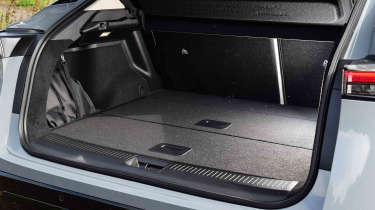
Pros |
Cons |
|
|
|
Dimensions | |
| Length | 4.595mm |
| Width | 1,850mm |
| Height | 1,660mm |
| Number of seats | 5 |
| Boot space | 408-466 litres |
Dimensions and size
The Ariya is 4,595mm long, 1,850mm wide and 1,660mm tall, which means it’s slightly bigger all-round than its Nissan Qashqai sibling but a little smaller than the Nissan X-Trail. Compared to other successful family EVs, the Hyundai Ioniq 5 is longer and wider than the Ariya, while the Skoda Enyaq also has a larger footprint.
Driving position, seats & space in the front
The Nissan Ariya is a very comfortable car to spend time in. The flat floor and sliding centre console give excellent cross-cabin access for getting kids out of the car on the side nearest the kerb or away from parked cars. The sliding centre console, offered with electric power as standard on Evolve models, also includes extra storage, but not as much as you might hope given its size.

Seats & space in the back
Rear passengers will welcome the generous space on offer, including the under-seat foot room. The centre seat is particularly comfortable compared to rivals such as the Volkswagen ID.5 and Genesis GV60, although we still wouldn’t recommend it for an adult on a long journey. Two six-foot tall rear passengers can sit very comfortably behind a driver and passenger of a similar size, although the seat base is quite low to the floor, so they will have to bunch their knees up a little.
There are two ISOFIX points on the outer positions of the rear bench and these are neatly concealed in zip-up slits in the seat bases, which allow for very easy access.
Boot space
At 466 litres for the regular front-wheel drive Ariya, the boot’s volume is merely okay. The Ariya has the same handy divider panel set-up as its smaller sibling, the Nissan Qashqai, which means you can separate items in the boot or stop them sliding towards the back seats. You can even raise the panels to create a flat boot floor to eliminate any annoying loading lip.
Overall volume isn’t far from that of the Kia EV6, but that car has the benefit of a front boot under the bonnet, which works as a great way of separating the potentially dirty charging cables from your clean luggage. All that’s under the bonnet of the Ariya is the front electric motor, a lot of wiring, and coolant hoses.
The four-wheel drive Ariya e-4ORCE has an even smaller boot at 408 litres. That’s because the rear-mounted electric motor powering the rear wheels lives beneath the luggage area, so the boot floor of e-4ORCE models has to be raised to accommodate it, thus reducing overall capacity. This means that there’s nowhere to store the charging cables out of the way in the 4x4 cars, you have to coil them up in the cloth bags provided and leave them at the sides of the boot.
All Nissan Ariya versions come with a 60/40 split folding rear seat if you need to utilise its maximum boot capacity of up to 1,350 litres, although that folding arrangement isn't as handy as the more flexible 40/20/40 you’ll find in the BMW iX1.
Towing
Front-wheel drive versions of the Ariya are rated to tow a braked trailer weight of 750kg, but this grows up to 1,500kg if you spring for the four-wheel drive e-4ORCE model. That should be enough to take a decent-size caravan on a family trip. If you need more capacity, a Volvo EX30 can pull up to 1,600kg.
“The Ariya generally makes the most of its EV platform to boost its practicality. The flat floor gives great cross-cabin access, which is helped by the powered, sliding centre console. You can either move this forward to help those in the rear, or move it back and make it easier for those in the front to get out of the opposite door.” - Steve Walker, head of digital content, who lived with a Nissan Ariya as part of our long-term fleet.
Reliability & safety
Pros |
Cons |
|
|
In 2022, independent safety experts at Euro NCAP awarded the Nissan Ariya its top five-star score. Nissan's family EV received an 86 per cent score for adult occupant protection, 89 per cent for child occupant protection, and 93 per cent for safety assistance systems.
Standard kit includes the ProPilot suite of semi-autonomous safety systems, which provides various driving assistance features to help make driving safer, and a little less stressful. You get an adaptive cruise control system to help keep you a safe distance from the car in front. There’s also a Blind Spot monitoring system to warn you of vehicles alongside you when you change lanes, and a lane keep assistance system to help keep you within your lane on a motorway drive. Traffic Sign Recognition warns you of the current speed limit, a Rear Cross Traffic Alert system to alert you of vehicles crossing your path while reversing, and an automatic emergency braking that aims to avoid or mitigate collisions at low speeds with pedestrians, cyclists, and other cars on the road.
Top-spec models also come with a ProPilot Park system. Tap a button and the Ariya takes over steering, accelerator and braking to bring you into a parking space.
Key standard safety features |
Euro NCAP safety ratings |
|
|
Buying and owning
- Best buy: Nissan Ariya 63kWh Advance
While it doesn’t have the biggest battery, our top pick is the two-wheel drive Advance model fitted with the 63kWh pack. While it’s the smaller pack of the two, this unit returned an average of 3.2 miles per kWh during our testing, which equates to a real-world range of around 235 miles.
Opting for this trim level adds in a fair amount of useful extra kit while keeping the price under control. Wireless device charging, a heated front windscreen, heated seats, electronically adjustable front seats and Nissan’s ProPilot Assist tech are all thrown in as standard at this level, and we think they’re worthwhile investments.
Nissan Ariya alternatives
Nissan’s electric SUV faced steady competition upon its arrival, and the market has continued to grow since then. Buyers in this mid-size SUV space can choose from models like the Hyundai Ioniq 5, Kia EV6, Ford Mustang Mach-E, Skoda Enyaq, Volkswagen ID.4 and Toyota bZ4X. There’s also the Renault Scenic, which shares its underpinnings with the Ariya.
At the upper end, Nissan’s creation goes head-to-head with models like the Audi Q4 e-tron and Tesla Model Y on price, but in terms of quality, it’s not outclassed in that company. The Scenic, Skoda Enyaq and Hyundai Ioniq 5 are aligned on price with the lesser Ariya models.
In terms of non-electric cars, the Nissan X-Trail is similar in size, and then you have the other larger mid-size family SUVs like the Toyota RAV4 and Ford Kuga, which do a similar job. Unlike similarly sized and priced models like the Skoda Kodiaq and Peugeot 5008, the Ariya isn’t available with seven seats.
Latest deals on the Ariya and alternatives
Nissan Ariya e-4ORCE: long-term test
Our head of digital content, Steve Walker, spent six months with the Nissan Ariya as part of our long-term fleet. Although it’s still a sturdy yet upmarket-feeling family car, Steve couldn’t help but feel that newer rivals are beginning to further highlight the ageing Ariya’s flaws. The Nissan’s dated infotainment system and mediocre efficiency were two key areas that proved particularly disappointing.
On the plus side, Steve found the Ariya to be comfortable and spacious enough for his whole family. However, while it feels like a premium model in places, Nissan’s electric SUV is priced like one, too. Steve’s dual-motor e-4ORCE Evolve variant costs a whopping £57,580, including options. You can read the full long-term test here…
Nissan Ariya pictures
Frequently Asked Questions
The Nissan Ariya stands out in the electric family SUV class thanks to its bold styling and wonderfully spacious cabin, and we've been impressed by the performance and refinement in all the versions we’ve tested.
New & used car deals
